Kanyakumari Weekend-Group Trip
Kanyakumari Weekend-Group Trip
Experience The Unique Sunrise and Sunset Simultaneously On All Full Moon Days
Admire The Historical Monuments
Visit The Small Island Of Swami Vivekananda And The Towering Stone Statue Of Tamil Poet Thiruvalluvar
Visit The Historic And Magnificent Shrine Of Goddess Kanya Kumari With The Diamond Nose Pin
Enjoy The Scenic Beauty From Circular Fort
Visit The Wonderful Tirparappu Water Falls
Witness The Beauty of Padmanabapuram Palace
- includes
- excludes
Things to do in and around kanyakumari
How to reach kanyakumari?
We've established convenient pickup and drop options right in your vicinity. Simply download the app, book your package using your location, and inform us of your exact whereabouts. Additionally, we've outlined various routes to reach the destination, taking into account commonly used traffic patterns.
- Kanyakumari
Additional Information about Kanyakumari Weekend-Group Trip
Kanyakumari Weekend-Group Trip For enquiries
If you are looking to know more information about Kanyakumari Weekend-Group Trip, our team at kanyakumari will assist you personally through the below dedicated number
Kanyakumari Weekend-Group Trip address
Kanyakumari Weekend-Group Trip,
kanyakumari,
tamilnadu
Whatsplan's Kanyakumari Weekend-Group Trip contact number : +91 9842067265
Places covered in(13)
Vattakottai Fortkanyakumari, tamilnadu

Vattakottai Fort (or 'Circular Fort') is a seaside fort near Kanyakumari, Tamil Nadu the southern tip of India. It was built in the 18th century as a coastal defence-fortification and barracks in the erstwhile Travancore kingdom. It was constructed under the supervision of Captain Eustachius De Lannoy, an ex-Dutch naval officer of the Dutch East India Company, who became commander of the Travancore Army (the very army that defeated him in the Battle of Colachel) in the 18th century, after he earned the trust of the Travancore King Marthanda Varma. De Lannoy constructed Vattakottai, as part of the defence-fortifications he undertook throughout Travancore. Vattakottai Fort commands a picturesque view of both the sea on the one side, and the hills (Western Ghats) on the other. Another interesting feature near the site is a beach of black sands. It is about 7 km (4.3 mi) from Kanyakumari town. View of the hills from Vattakottai fort. View of the sea from Vattakottai fort.
Thirparappu Fallskanyakumari, tamilnadu
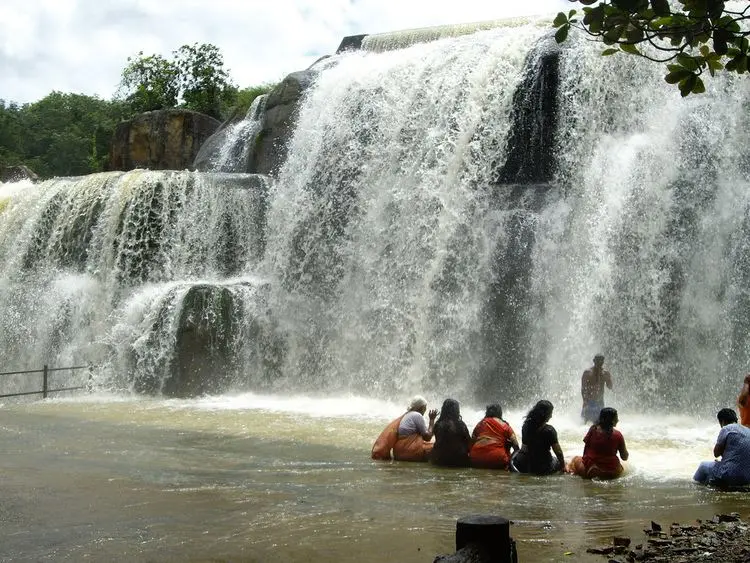
Thirparappu(Thriparappu) is famous for its waterfalls and is located in Kanyakumari District of Tamil Nadu in the southern part of India. Thirparappu (Thriparappu) Falls is located 42 km (26 mi) from Nagercoil (headquarters of Kanyakumari District), 55 km (34 mi) from Thiruvananthapuram (capital of Kerala) and a distance of 5 km (3.1 mi) from Kulasekaram (nearest town Panchayat). This famous falls is in the Kodayar (Kothai River). The Kodayar makes its descend at Thirparappu and the water fall at this place is about 13 km (8.1 mi) from Pechiparai dam.
Arulmiku Sri Nagaraja Temple nagercoil, tamilnadu
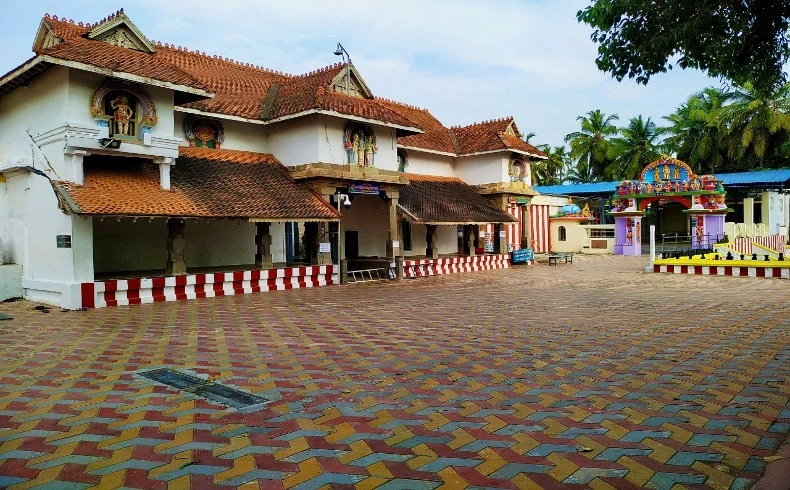
Session Opening Hours Morning 5:00 AM - 12:00 PM Evening 5:00 PM - 8:00 PMThe Nagaraja Temple in Nagercoil, Tamil Nadu, is a renowned Hindu temple dedicated to Nagaraja, the King of Serpents. Situated in the heart of Nagercoil town in Kanyakumari district, this temple holds deep religious significance, especially for devotees who worship serpent deities for protection, fertility, and the removal of sarpa dosha (snake-related afflictions in astrology).What sets this temple apart is the unique blend of Hindu and ancient Dravidian traditions. The main deity, Nagaraja, is enshrined beneath a thatched roof over sandy soil, where devotees offer turmeric, milk, and oil to serpent idols believed to hold divine power. The temple also houses shrines for Lord Shiva, Vishnu, and Devi, making it spiritually significant for multiple sects.Thousands of devotees visit the temple, particularly during Aadi and Avani months (July–September), when special pujas and rituals are performed. Many childless couples and those suffering from astrological afflictions come here to seek divine intervention.The temple’s tranquil environment, surrounded by palm trees and sacred groves, adds to its spiritual aura. With its ancient traditions, mystical legends, and powerful rituals, the Nagaraja Temple remains a key pilgrimage destination in South India.
Bhagavathi Amman Templekanyakumari, tamilnadu
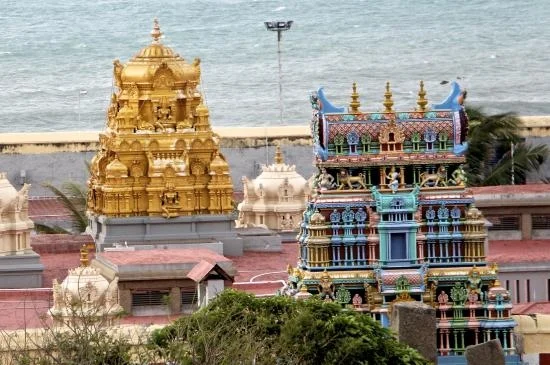
The Bhagavathi Amman Temple is revered by locals and pilgrims alike for its association with Goddess Bhagavathi, who is considered a powerful and benevolent deity. The temple holds religious significance for the people of Kanyakumari and is an essential part of the cultural and spiritual heritage of the region. The temple likely showcases traditional South Indian temple architecture. This may include a towering gopuram (entrance tower), intricately carved pillars, and a sanctum sanctorum housing the main deity, Goddess Bhagavathi. The temple architecture often reflects the rich cultural and artistic traditions of Tamil Nadu. The central deity of the Bhagavathi Amman Temple is Goddess Bhagavathi, who is worshipped in various forms across different regions of India. Devotees visit the temple to seek the blessings of the goddess for protection, prosperity, and well-being. The temple is likely a place of regular worship, with daily rituals and ceremonies performed by the temple priests. Additionally, the Bhagavathi Amman Temple may host special festivals and celebrations, attracting a significant number of devotees during these occasions. The temple is likely to be a pilgrimage destination for devotees who come from different parts of Tamil Nadu and beyond. Pilgrims visit the temple to offer prayers, make offerings, and participate in religious ceremonies. In addition to religious activities, the Bhagavathi Amman Temple may play a role in hosting cultural events and community gatherings. Temples often serve as focal points for various social and cultural activities in Indian communities. The temple's location in Kanyakumari is likely to provide scenic surroundings, as the city is known for its coastal beauty and is situated at the southernmost tip of the Indian subcontinent. The temple's setting may contribute to a tranquil and spiritually uplifting atmosphere.
Rasthakadu beachkanyakumari, tamilnadu
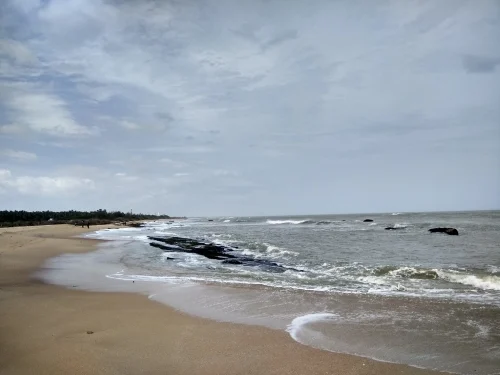
Rasthakadu beachis located close to the highway.Beachis very clean, peaceful and not much crowded. It has a beautiful view of Windmills on one side. Beaches in Kanyakumari are known for their picturesque settings, with golden sands, clear blue waters, and often framed by rocky cliffs or hills. The coastal area offers panoramic views of the Arabian Sea. Kanyakumari, being the southernmost tip of the Indian subcontinent, is famous for its stunning sunrise and sunset views. If Rasthakadu Beach is in Kanyakumari, it might be a great spot to witness the sun setting over the ocean. Many beaches in Kanyakumari have cultural and religious significance. The region is known for its temples, including the Vivekananda Rock Memorial and Thiruvalluvar Statue, both located in close proximity to the shore. Visitors to Kanyakumari beaches often engage in activities such as strolling along the shore, enjoying local cuisine at beachside eateries, and taking part in boat rides or other water-based activities if available. Kanyakumari is a place where the Arabian Sea, the Bay of Bengal, and the Indian Ocean meet. This confluence is considered sacred, and beaches in the area often have a spiritual and serene atmosphere.
Venkateshwara templekanyakumari, tamilnadu
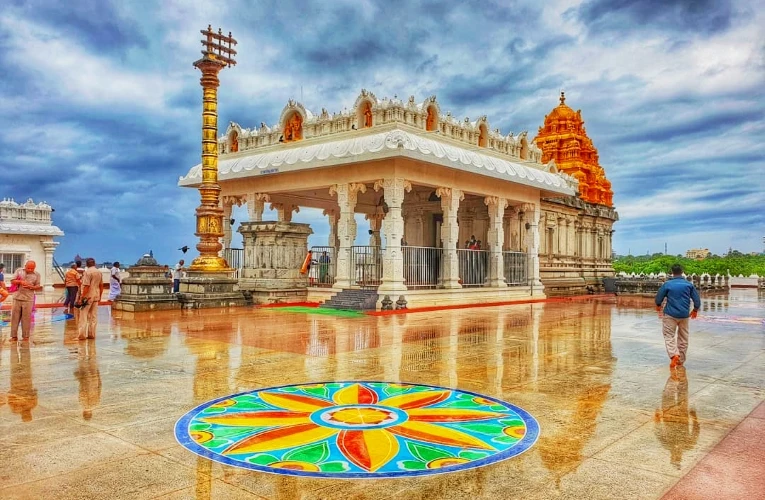
The Tirupati Venkateswara temple is located at the country’s southernmost tip close to the confluence of Indian Ocean, the Bay of Bengal and the Arabian Sea in Kanyakumari and is maintained by Tirumala Tirupati Devasthanams. The temple has been designed in such a way that sunlight will directly fall on the foot of the Venkateswara idol in the sanctum sanctorum on April 14 every year (on the occasion of Vishu). The Tirupati Temple in Kanyakumari was built to replicate the Tirupati Venkateswara Temple in Andhra Pradesh. It was inaugurated in 2019 and constructed on land covering an area of 5.5 acres on the premises of the Vivekananda Kendra situated near the shore in Kanyakumari. Thousands of devotees from Kerala and Andhra Pradesh took part in the celebrations and paid their respects. The temple’s construction started in July of 2013 and was designed so that the sunlight falls directly on the foot of the idol on the occasion of Vishu every year. Special sweets were brought all the way from Tirupati Devasthanam to be distributed as prasad. The nearby towns arranged for special buses for guests and devotees to witness this pious occasion. About 2000 people were employed to keep the security in check. The temple is open to the public every day from 6 am and closes at different times on different days. It closes at 7 pm on Sundays, 11:30 pm on Mondays, and 8 pm on Tuesdays to Fridays. It’s open from 6 am to 6:45 am on Saturdays, after which it opens again at 9:30 am and closes at 8 pm. You can keep aside about an hour and 30 minutes to offer your prayers at this temple.
Sunrise Viewpointkanyakumari, tamilnadu
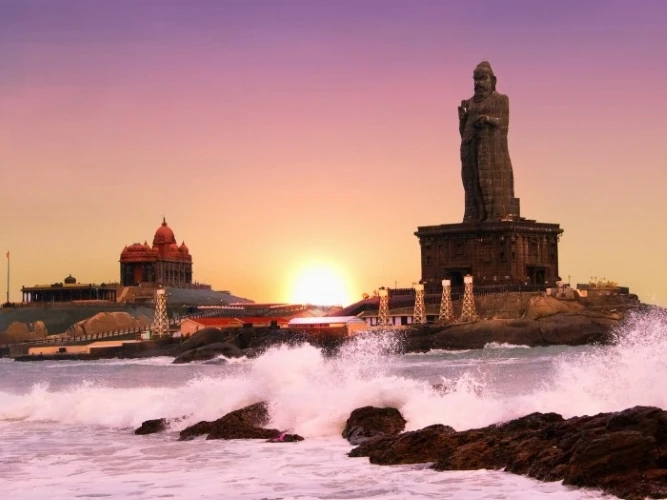
<p>Kanyakumari, located at the southernmost tip of India, is known for its stunning sunrise and sunset views. The sunrise viewpoint in Kanyakumari is a popular spot where visitors gather to witness the spectacle of the sun rising over the confluence of the Arabian Sea, the Bay of Bengal, and the Indian Ocean. The sunrise viewpoint is strategically located on the eastern coast of Kanyakumari, offering an unobstructed view of the horizon where the sun emerges from the sea. The sunrise viewpoint is often associated with the iconic Vivekananda Rock Memorial and the Thiruvalluvar Statue. These landmarks add to the scenic beauty of the location. The sunrise is a magical moment, and visitors usually arrive early in the morning to secure a good vantage point. As the sun begins to rise, the sky transforms into a canvas of vibrant colors, ranging from soft hues of pink and orange to brilliant gold. The changing colors create a breathtaking panorama over the vast expanse of the sea. Kanyakumari is unique because it is the point where the three major water bodies—the Arabian Sea, the Bay of Bengal, and the Indian Ocean—converge. The sunrise viewpoint offers a panoramic view of this confluence, enhancing the beauty of the sunrise. The silhouette of the Vivekananda Rock Memorial against the backdrop of the rising sun adds a spiritual and serene dimension to the sunrise experience. The Thiruvalluvar Statue, a colossal statue of the ancient Tamil poet and philosopher, stands tall nearby. It becomes gradually visible as the daylight increases, creating a striking contrast against the morning sky. The sunrise viewpoint is a favorite among photographers who capture the captivating moments as the sun ascends, casting its warm glow on the sea and the surrounding landscape. The early morning hours at the sunrise viewpoint are characterized by a calm and tranquil atmosphere.</p>
Thanumalayan templenagercoil, tamilnadu
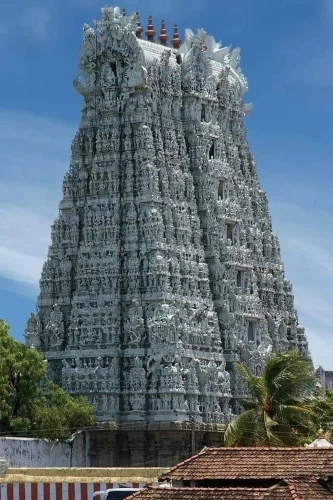
Session Opening Hours Morning 4:30 AM to 12:00 PM Evening Evening 5:00 PM to 8:30 PM.Suchindram Temple – A Sacred Abode of the Trinity:The Suchindram Thanumalayan Temple, located about 13 km from Kanyakumari in Tamil Nadu, is a renowned and sacred Hindu temple celebrated for its unique dedication to the Trimurti—Brahma (creator), Vishnu (preserver), and Shiva (destroyer)—all worshipped in a single sanctum as Thanumalayan. The name "Thanumalayan" itself is derived from Thanu (Shiva), Mal (Vishnu), and Ayan (Brahma). This rare unity makes the temple a spiritually significant site for devotees from all over India. The temple is a stunning example of Dravidian architecture, adorned with intricately carved stone pillars, towering gopurams (temple towers), and ancient inscriptions. Among its highlights are the 18-foot-tall monolithic statue of Lord Hanuman, one of the tallest in South India, and a massive Nandi (bull) sculpture carved from a single stone. The temple is also famed for its musical pillars that emit different tones when tapped. Besides its architectural marvels, the temple holds deep mythological importance, believed to be the place where Lord Indra was cleansed of his sins. Rich in history, spirituality, and artistic heritage, the Suchindram Temple remains a must-visit for devotees, pilgrims, and heritage lovers alike.
Vivekananda rock memorialkanyakumari, tamilnadu
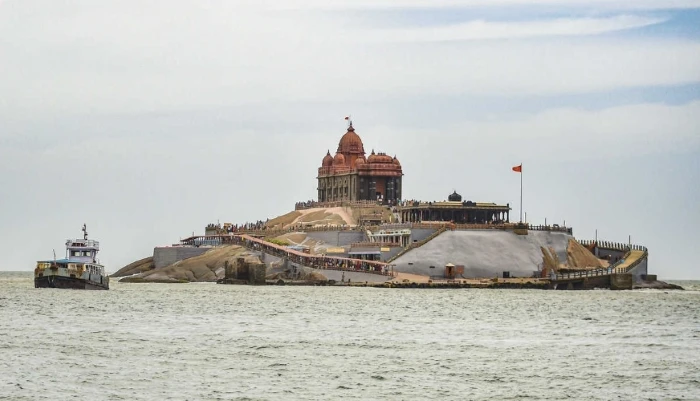
The Vivekananda Rock Memorial is a prominent monument and spiritual pilgrimage site located on a rocky island off the coast of Vavathurai, near Kanyakumari in Tamil Nadu, India. The Vivekananda Rock Memorial is situated on a small rocky island in the Laccadive Sea, at the southernmost tip of the Indian subcontinent, where the Bay of Bengal, the Arabian Sea, and the Indian Ocean converge. The memorial is dedicated to Swami Vivekananda, a renowned Hindu monk and philosopher who played a key role in introducing Indian philosophies of Vedanta and Yoga to the Western world. The memorial is built in a unique architectural style that combines traditional Indian and modern architectural elements. It reflects the spiritual and cultural ethos that Swami Vivekananda represented. The Vivekananda Rock Memorial consists of two main structures—the Vivekananda Mandapam and the Shripada Mandapam. The Vivekananda Mandapam is the main hall and houses a bronze statue of Swami Vivekananda. The bronze statue of Swami Vivekananda is placed in the Dhyana Mandapam within the Vivekananda Mandapam. The statue captures a moment of deep contemplation and meditation.The Shripada Mandapam is a smaller hall that enshrines a 'Shripada' (Divine Footprint), believed to be the spot where the Goddess Kumari performed austerity. The architecture of the memorial is symbolic, representing the spiritual journey of Swami Vivekananda. The structures are designed to withstand the powerful oceanic currents in the region. The rock on which the memorial is built is known as Vivekananda Rock, and it is believed to be the place where Swami Vivekananda meditated and attained enlightenment.. Visitors reach the Vivekananda Rock Memorial by ferry, which operates from the mainland. The ferry ride itself offers scenic views of the surrounding seas and landscapes. The memorial stands as a symbol of religious harmony and unity. Swami Vivekananda's teachings emphasized the universality of religions and the importance of tolerance and understanding among diverse faiths. The location of the Vivekananda Rock Memorial offers breathtaking views of both sunrise and sunset over the confluence of the three seas, making it a popular spot for visitors seeking a serene and spiritually charged experience. The memorial includes a meditation hall for visitors to engage in contemplation and meditation, fostering a tranquil environment. The Vivekananda Rock Memorial is not only a significant pilgrimage site for followers of Swami Vivekananda but also a cultural and architectural landmark that attracts tourists and spiritual seekers from around the world. It stands as a tribute to the teachings and philosophy of this revered spiritual leader.
Sanguthurai beachkanyakumari, tamilnadu
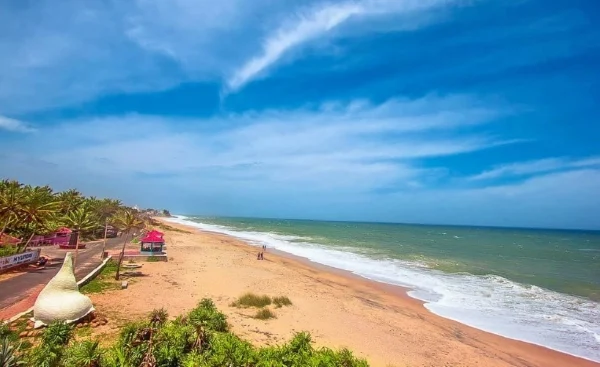
Sanguthurai Beach is known for its natural beauty, featuring golden sands, clear blue waters, and a serene atmosphere. The beach offers panoramic views of the Arabian Sea and is a peaceful escape for both locals and tourists. Like many coastal areas in Kanyakumari, Sanguthurai Beach is likely to be an excellent spot to witness breathtaking sunsets. The changing colors of the sky as the sun sets over the horizon create a picturesque and tranquil setting. The coastline in the Kanyakumari region is often characterized by unique rock formations, and Sanguthurai Beach may have interesting geological features along its shoreline. These formations can add to the overall charm of the beach and provide opportunities for exploration. Given Kanyakumari's reputation as a significant pilgrimage destination, the beach may be located near temples or other religious sites. The region is known for its cultural and religious diversity, and visitors to Sanguthurai Beach may have the chance to explore these aspects of the local culture. Sanguthurai Beach is likely to offer a more relaxed and less crowded atmosphere compared to some other popular beaches in the area. This makes it an ideal place for those seeking tranquility and a break from the hustle and bustle. Nearby vendors and eateries may offer local cuisine and refreshments. Visitors may have the opportunity to try regional delicacies and snacks. Additionally, beachside activities such as camel rides or boat rides might be available. Sanguthurai Beach is likely to be easily accessible, and visitors may choose to reach it by local transport or private vehicles. The surrounding area may have facilities for parking and other amenities.
Sunset pointkanyakumari, tamilnadu
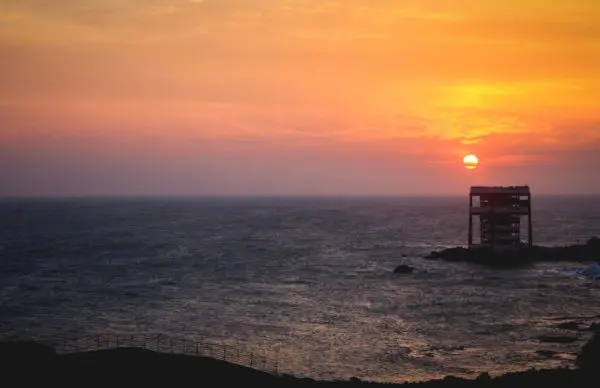
<p>Sunset Point provides an unobstructed view of this unique meeting of the seas, making it a captivating location for witnessing the sunset. The Sunset Point offers panoramic views of the vast expanse of the sea and the horizon. Visitors can witness the sun gradually descending below the horizon, casting hues of orange, pink, and purple across the sky and reflecting on the calm waters. The changing colors create a breathtaking visual spectacle. From Sunset Point, one can also enjoy views of prominent landmarks, including the Thiruvalluvar Statue and the Vivekananda Rock Memorial. The confluence of the seas is considered symbolic, and many visitors gather at Sunset Point to experience the tranquility and spiritual energy of the surroundings. Sunset Point is a major tourist attraction in Kanyakumari, drawing visitors from around the world who come to witness the breathtaking natural spectacle. The calm and serene ambiance, combined with the stunning views, make it a memorable experience for tourists. Near Sunset Point, there is a lighthouse that offers an additional elevated perspective of the surroundings. Climbing to the top of the lighthouse provides visitors with a bird's-eye view of the seas and the coastal landscape, enhancing the overall experience. The picturesque setting of Sunset Point makes it a paradise for photography enthusiasts. The changing colors of the sky, the silhouette of the Thiruvalluvar Statue, and the serene waters provide ample opportunities to capture stunning moments. As the sun sets, the atmosphere at Sunset Point becomes tranquil and serene.</p>
Thiruvalluvar Statuekanniyakumari, tamilnadu
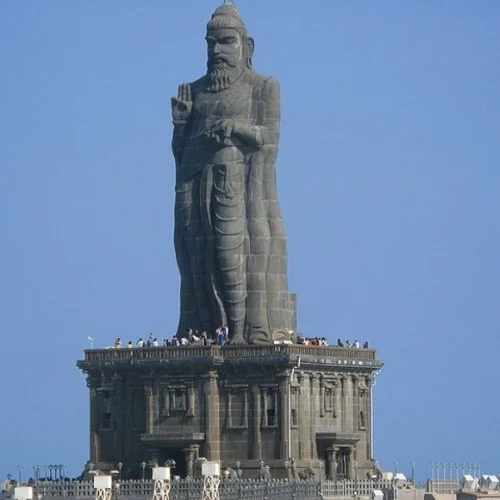
The Thiruvalluvar Statue is a renowned monument dedicated to the ancient Tamil poet and philosopher Thiruvalluvar. The statue is located in Kanyakumari, Tamil Nadu, India, at the southernmost tip of the Indian subcontinent, where the Arabian Sea, the Bay of Bengal, and the Indian Ocean converge. The statue is named after Thiruvalluvar, a celebrated Tamil poet and philosopher believed to have lived around 2,000 years ago. He is best known for his work "Thirukkural," a classic Tamil text consisting of couplets covering various aspects of life and ethics. The statue is a 133-feet tall stone structure, representing the 133 chapters of Thirukkural. It was inaugurated on January 1, 2000, by the then Chief Minister of Tamil Nadu, M. Karunanidhi. The 38-foot pedestal on which the statue stands represents the 38 chapters of virtue in Thirukkural. The statue is made of 7000 blocks of granite brought from the nearby town of Ambasamudram. Each block was sculpted separately and then assembled to create the final structure. The statue symbolizes the cultural and linguistic identity of the Tamil people and serves as a tribute to the literary and philosophical contributions of Thiruvalluvar.
Triveni Sangamamkanyakumari, tamilnadu
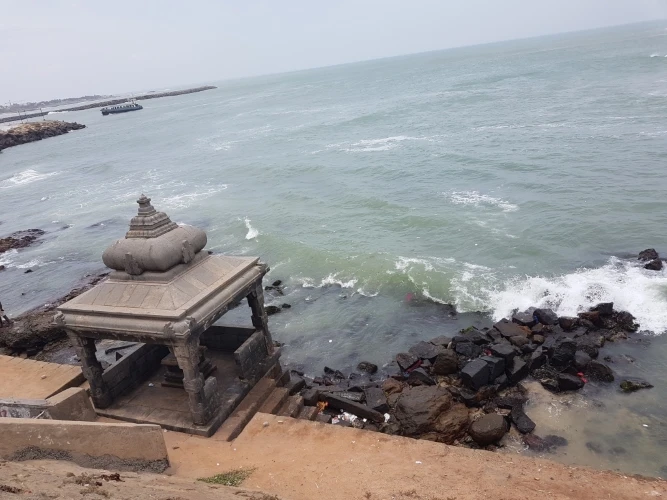
Triveni Sangamam in Kanyakumari is a sacred confluence of three water bodies, namely the Bay of Bengal, the Arabian Sea, and the Indian Ocean. This geographical phenomenon holds immense cultural and spiritual significance for the people who visit Kanyakumari, the southernmost tip of the Indian subcontinent. At the southernmost tip of India, where the land meets the vast expanse of the three great seas—Bay of Bengal, Arabian Sea, and the Indian Ocean—lies Triveni Sangamam, a sacred convergence that captivates the hearts of pilgrims and tourists alike. The term "Triveni Sangamam" translates to the meeting point of three rivers, symbolizing the union of the three major water bodies that surround the Indian subcontinent. Triveni Sangamam is not just a meeting of seas but a geographical marvel where the waters of the Bay of Bengal, the Arabian Sea, and the Indian Ocean merge seamlessly. Each sea is distinguishable by its unique color and characteristics, creating a visual spectacle as they come together in a harmonious union. For centuries, Triveni Sangamam has held deep spiritual and cultural significance. The location of Triveni Sangamam at the southern tip of the subcontinent offers breathtaking views of both sunrise and sunset. The sun emerges majestically over the waters, casting hues of orange and gold across the horizon. At sunset, the sky transforms into a canvas of vibrant colors, creating a serene and contemplative atmosphere. Triveni Sangamam is not only a spiritual hub but also a place where the diverse cultural tapestry of India unfolds. Visitors from different parts of the country and the world come to witness the meeting of the three seas and to experience the cultural richness of Kanyakumari.